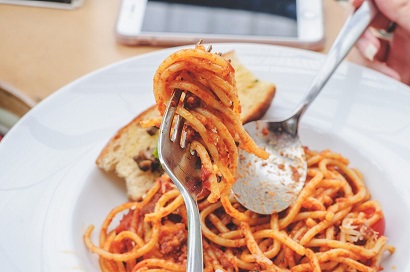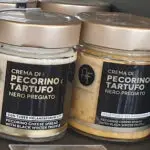Many people believe that Italians eat spaghetti with a fork and spoon. While this is technically true, it is not the whole story.

In Italy, spaghetti is typically eaten with a fork, but the spoon is used for a specific purpose. The spoon is used to scoop up a small amount of sauce, which is then eaten along with the pasta. This practice helps to prevent the sauce from becoming too diluted, and it also allows diners to control the amount of sauce that they consume.
As a result, while Italians do use a fork and spoon when eating spaghetti, the spoon serves an important functional role rather than being used as an implement for eating the pasta itself.
The History of Spaghetti
The earliest known reference to spaghetti comes from a British travelogue published in 1779. The author, Francis Mason, noted that spaghetti was commonly eaten in Naples and was “muchly esteemed” by the city’s residents. However, it wasn’t until the mid-19th century that spaghetti began to gain popularity outside of Italy.
Spaghetti became widely known in North America after the publication of Mark Twain’s 1867 book The Innocents Abroad. In one passage, Twain described seeing “long lines of men and women at work in the streets…and these were making macaroni!” Of course, Twain was actually referring to spaghetti, but his readers didn’t know that. As a result, many Americans came to believe that macaroni and spaghetti were two different dishes.
It wasn’t until the early 20th century that spaghetti became a staple of the American diet. In 1903, the first U.S.-based pasta company—the New York Macaroni Company—was founded.
This company popularized the use of dry pasta, which could be stored on shelves for long periods of time. Prior to this, fresh pasta was the only type available, and it had to be consumed within days of being made.
Today, Italian food is a staple in the U.S., and various pasta dishes are served throughout the country.
How to Eat Spaghetti the Italian Way
The first thing you need to know is that Italians never, ever use a spoon to eat spaghetti. That’s because they believe that using a spoon defeats the purpose of twirling the noodles around your fork. And twirling is an essential part of eating spaghetti the Italian way. In fact, if you don’t twirl your noodles, you might as well not bother eating them at all.
Second, Italians never sauce their pasta before they twirl it. This may seem counterintuitive, but trust us, it works. By waiting to sauce your pasta until after you’ve twirled it, you ensure that each and every noodle is coated in deliciousness.
Finally, Italians always finish their plate of spaghetti. That’s because they believe that leaving food on your plate is disrespectful to the person who cooked the meal. So even if you’re feeling full, make sure you clean your plate before getting up from the table.
The Benefits of Eating Pasta the Italian Way
The Italian Way Is Good for Your Heart
One of the main benefits of eating pasta the Italian way is that it’s good for your heart. This is because the typical Italian diet is rich in healthy fats, including olive oil, which has been shown to reduce bad cholesterol and improve heart health. Additionally, pasta is a good source of complex carbohydrates, which help to regulate blood sugar levels and prevent spikes in insulin levels.
The Italian Way Is Good for Your Gut
Another benefit of eating pasta the Italian way is that it’s good for your gut. This is because pasta contains resistant starch, a type of dietary fiber that feeds the beneficial bacteria in your gut and promotes a healthy digestive system. Additionally, the antioxidants in olive oil help to protect your gut from inflammation.
The Italian Way Can Help You Lose Weight
Contrary to popular belief, eating pasta the Italian way can actually help you lose weight. This is because the typical Italian diet is relatively low in calories and saturated fat but high in fiber, which helps you feel full and satisfied after meals. Additionally, research has shown that people who eat a Mediterranean diet are less likely to become obese than those who don’t.
So there are surprisingly many good reasons why Italians eat pasta.
Recipes for Spaghetti Dishes the Italian Way
Spaghetti with Tomato Sauce
Ingredients:
-1 pound spaghetti
-1 tablespoon olive oil
-1 onion, diced
-3 cloves garlic, minced
-2 tablespoons tomato paste
-1 (28-ounce) can of crushed tomatoes
-1 teaspoon sugar
-1 teaspoon dried basil
-1/2 teaspoon salt
-1/4 teaspoon ground black pepper
-1/4 cup chopped fresh parsley leaves
Directions:
1. Cook pasta according to package instructions. Drain.
2. Heat olive oil in a large saucepan over medium heat. Add onion and garlic, and cook until softened, about 5 minutes. Stir in tomato paste until combined. Add crushed tomatoes, sugar, basil, salt, and pepper. Bring to a simmer and cook until the sauce has thickened, about 15 minutes.
3. Serve sauce over cooked pasta, and sprinkle with parsley leaves. Enjoy!
Et voila, you are now an expert in cooking pasta and know again a little more about Italian culture.
Fun Facts About Italians and Their Cuisine
Italy is a country with a rich history and culture. Italians are passionate about many things, including food! Here are 10 fun facts about Italy and its cuisine that you may not know.
- The first pizza was made in Naples, Italy in 1889.
- In Italy, there is no such thing as breakfast, lunch, and dinner. There is only pranzo, which refers to the main meal of the day that is eaten around 2 pm.
- Spaghetti and meatballs are not traditional Italian dishes! The dish was actually created by Italian immigrants in the United States.
- There are more than 350 types of pasta produced in Italy.
- Italians do not put cheese on fish dishes because they believe it overpowers the taste of the fish.
- Tiramisu means “pick me up” or “cheer me up.” The dessert was created in Treviso, Italy in the 1960s and is traditionally made with coffee-soaked ladyfingers, marsala wine, mascarpone cheese, and cocoa powder.
- Olive oil is not just used for cooking in Italy. It is also used as a dip for bread, a dressing for salad, and even as a moisturizer for skin and hair!
- There are more than 2,000 varieties of grapes grown in Italy, making it the country with the most diverse selection of grapes in the world.
- Tomatoes were actually brought to Europe from South America by the Italian explorer Christopher Columbus in 1493. They were initially used as decoration because people believed they were poisonous.
- Basil, mint, oregano, rosemary, sage, and thyme are all native to Italy! These herbs are commonly used in Italian cuisine to add flavor to dishes without masking the taste of the main ingredients.
- The Top Restaurants Specializing in Truffle Dishes - August 10, 2023
- Truffle Panna Cotta: A Decadent Dessert Recipe for Truffle Lovers - August 7, 2023
- Truffle Scrambled Eggs: A Luxurious Breakfast Delight - August 7, 2023








